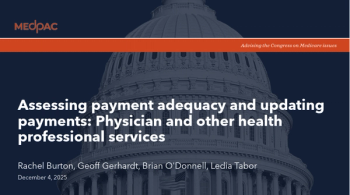
- December 10, 2018 edition
- Volume 95
- Issue 23
Don’t drink the healthcare consolidation Kool-Aid
Don’t be fooled. When mergers occur, patients and physicians lose; executives at the top are the only ones who truly win.
Editor's Note: Welcome to Medical Economics' blog section which features contributions from members of the medical community. These blogs are an opportunity for bloggers to engage with readers about a topic that is top of mind, whether it is practice management, experiences with patients, the industry, medicine in general, or healthcare reform. The opinions expressed here are that of the authors and not UBM / Medical Economics.
The troubling trend of healthcare consolidation is gaining momentum, and Americans are paying a heavy price. Not only is this merger mania destroying our nation’s healthcare system, but it’s also decimating our middle class. However, if consolidation is healthcare’s cancer, consumers are the cure.
Every week, we hear reports of hospitals buying up doctor’s practices and merging with other hospitals. For example: Advocate Health Care and Aurora Health Care finalized their $11 billion deal last April to form the nation’s 10th largest tax-exempt health system; Dignity Health and Catholic Health Initiatives are marching toward a $28 billion deal.
More recently, we’ve heard about insurers merging with health providers and retail pharmacies: UnitedHealth’s subsidiary Optum is buying DaVita Medical Group, a group of several hundred independent doctors and clinics, for nearly $5 billion. In April, Medicare insurance giant Humana bought 22-clinic Family Physicians Group in Central Florida. Now rumor has it Walmart might buy Humana. And, of course, CVS Health Corp. and Aetna continue to move toward their $69 billion union.
Many, many smaller deals go through weekly.
Mergers were up 13 percent last year, setting a record for the most healthcare mergers and acquisitions in recent history, according to a Kaufman Hall report. The first quarter of 2018 was the busiest start for healthcare mergers in over a decade, according to Bloomberg.
None of this bodes well for consumers.
Regardless of what the merging parties say about streamlining care and greater efficiencies, when healthcare entities merge, costs only go one way: up, way up. Ask those trying to convince you of the benefits to point to one study that shows costs go down after a merger, or that quality goes up. They can’t.
A recent study from the nonprofit Physicians Advocacy Institute reported that hospitals buying up doctors was the leading driver in soaring Medicare costs. Between 2012 and 2015, Medicare costs rose $3.1 billion due primarily to the 49 percent uptick in hospital-employed doctors that occurred over the same period. And that study only looked at four procedures. Imagine the tally if all procedures were accounted for.
When hospitals merge, price increases on the order of 20 percent to 30 percent are common, and can exceed 50 percent, said Carnegie Mellon economist Martin Gaynor in a recent report. What’s more, he added, many studies have found that patient health outcomes are substantially worse at hospitals in concentrated markets where there is less competition.
The only parties who benefit when healthcare entities merge are the executives at the top.
The cure for consolidation cancer
Meanwhile, consumers foot the bill in the way of higher premiums and more tax dollars going to pay for healthcare.
No wonder healthcare bills are the number one reason Americans declare bankruptcy, and healthcare costs consume 20 percent of the average family’s budget.
Yet health entities continue to merge, grow, gain market share, and increase their bargaining power with payers. The bigger they are, the more they get. So the mergers continue. Until someone does something.
But who?
Not the hospitals. They lobbied hard to get the system here, and they’re profiting handsomely. Every time they merge, they profit more.
Not the insurance companies. They have no incentive to bring premiums down, especially since under the Affordable Care Act’s “Medical Loss Ratio” rule, which states that insurers can keep only 20 percent of every healthcare dollar, and put at least 80 percent must go toward claims, or rebate the rest. Though presumably well-intentioned, the government’s plan backfired. Insurers quickly figured that 20 percent of a higher premium is more than 20 percent of lower one, so guess which way premiums have gone?
Not lawmakers. An eye-opening visit to opensecrets.com will tell you how much money your representative gets in campaign funding from hospitals and insurance companies. The American Hospital Association alone spent $22 million in 2017 lobbying lawmakers.
That leaves the rest of us. Educated consumers and brave physicians are the cure for consolidation cancer.
As physicians, we can start to change the market by remaining or becoming independent, by referring only to other independent doctors and free-standing outpatient centers, and by educating patients about why they, too, must only go to independent doctors. We also must push for transparency in healthcare pricing, so consumers can shop for healthcare based on price and value, and-most important-we must just say no when slick-talking executives come to town serving up pitchers of “consolidation Kool-Aid.”
If we don’t, we can expect a lot more of our money to pour directly into health executives’ pockets, covering the cost for their skyboxes.
Marni Jameson Carey is the executive director of the Association of Independent Doctors, a national nonprofit organization. Prior to joining AID, she was a senior health reporter for Tribune Media, writing for the Los Angeles Times and the Orlando Sentinel. A nationally syndicated columnist, she is also the author of four books. Jameson Carey can be reached at [email protected].
Articles in this issue
about 7 years ago
EHR certification: Is the latest standard attainable?about 7 years ago
Manage asthmaabout 7 years ago
Mirrors & miragesabout 7 years ago
Physician employment: How to find the right fitabout 7 years ago
Surviving merger maniaabout 7 years ago
The value of the direct pay monthly fee to physicians and patientsabout 7 years ago
Can you put a price on patient relationships?about 7 years ago
Cracking the code behind the patient revenue cycleNewsletter
Stay informed and empowered with Medical Economics enewsletter, delivering expert insights, financial strategies, practice management tips and technology trends — tailored for today’s physicians.
















